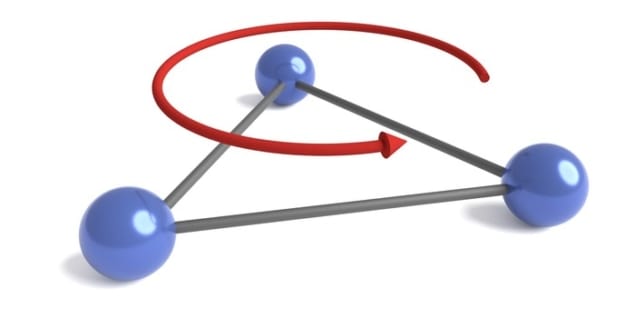
A new theory describing how energy and information could be made to flow in one direction around a cluster of three interacting quantum systems has been developed by Charles Downing at the University of Exeter and David Zueco at the University of Zaragoza. Their work could inspire the design of new nanoscale components for manipulating interactions between energy and matter.
The concept of reciprocity can be found throughout nature: from altruism in the animal kingdom, to Newton’s third law, in which every action must have an equal, opposite reaction. Sometimes this two-way flow can be broken, and this can lead to the development of useful components such as diodes – which only allow electrical currents to flow in one direction.
Today, condensed matter physics is seeing an explosion of interest in the fabrication of nanostructures that deliver non-reciprocity on molecular scales. These systems often exploit the laws of quantum mechanics and involve the use of metamaterials, which have revolutionized our control over interactions between light and matter.
Synthetic magnetic fields
In a landmark 2017 study, a team led by Pedram Roushan at the University of California, Santa Barbara (now at Google), created a triangular loop of three superconducting qubits around which photons could only circulate in one direction. In this quantum trimer, the direction of flow could be tuned using synthetic magnetic fields, which were generated by sinusoidally varying the strength of coupling between the three qubits.
Building on this work, Downing and Zueco have designed a more general theoretical description of a quantum trimer based on a triangular cluster of two-level quantum systems. These each exist in a superposition of two quantum states – and could be created in the lab from a wide variety of physical systems. These include superconducting qubits, ultracold atoms, and quantized plasma oscillations (plasmons) in metallic nanoparticles.
The duo showed that by adjusting the synthetic magnetic field, they could control the direction of the energy flow around the cluster. The setup allowed them to study the full range of excitations that are possible in their triangular cluster, rather than just a single excitation. They were also able to consider the pernicious effects of energy dissipation on non-reciprocal quantum currents.
Exotic states of matter
Their results pave the way for new experimental studies of nanoscale directional currents, which could lead to the development of new ways of controlling the flow of energy and information. The research could also lead to new studies of exotic states of matter that feature strongly interacting quantum systems.

Quantum computer shows that time crystals are phases of matter
“Our calculations provide insight into how one may instigate directional transport in closed nanoscopic lattices of atoms and photons with strong interactions, which may lead to the development of novel devices of a highly directional character,” says Downing.
The research is described in the Proceedings of the Royal Society A.



